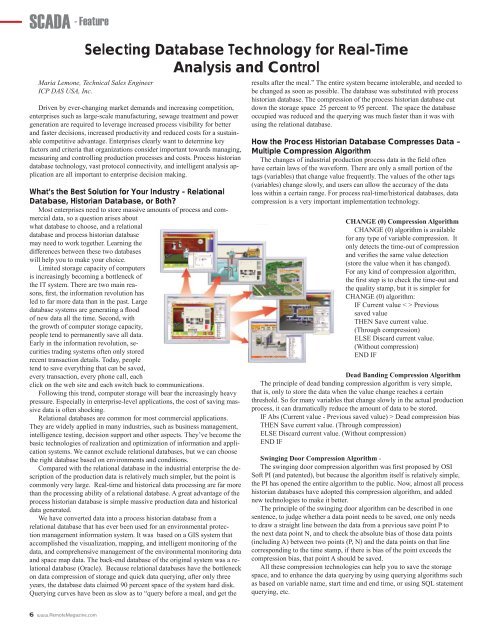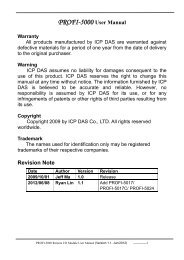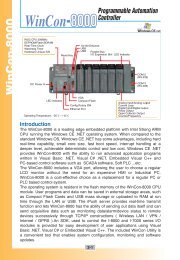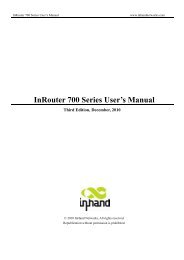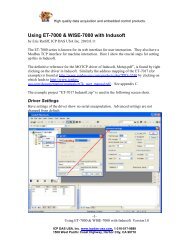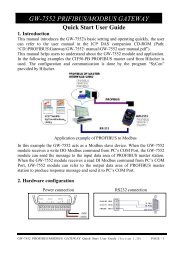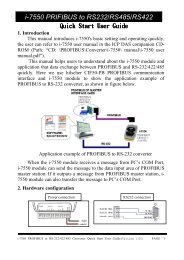Contents - ICP DAS USA
Contents - ICP DAS USA
Contents - ICP DAS USA
You also want an ePaper? Increase the reach of your titles
YUMPU automatically turns print PDFs into web optimized ePapers that Google loves.
SCADA - FeatureSelecting Database Technology for Real-TimeAnalysis and ControlMaria Lemone, Technical Sales Engineer<strong>ICP</strong> <strong>DAS</strong> <strong>USA</strong>, Inc.Driven by ever-changing market demands and increasing competition,enterprises such as large-scale manufacturing, sewage treatment and powergeneration are required to leverage increased process visibility for betterand faster decisions, increased productivity and reduced costs for a sustainablecompetitive advantage. Enterprises clearly want to determine keyfactors and criteria that organizations consider important towards managing,measuring and controlling production processes and costs. Process historiandatabase technology, vast protocol connectivity, and intelligent analysis applicationare all important to enterprise decision making.What’s the Best Solution for Your Industry - RelationalDatabase, Historian Database, or Both?Most enterprises need to store massive amounts of process and commercialdata, so a question arises aboutwhat database to choose, and a relationaldatabase and process historian databasemay need to work together. Learning thedifferences between these two databaseswill help you to make your choice.Limited storage capacity of computersis increasingly becoming a bottleneck ofthe IT system. There are two main reasons,first, the information revolution hasled to far more data than in the past. Largedatabase systems are generating a floodof new data all the time. Second, withthe growth of computer storage capacity,people tend to permanently save all data.Early in the information revolution, securitiestrading systems often only storedrecent transaction details. Today, peopletend to save everything that can be saved,every transaction, every phone call, eachclick on the web site and each switch back to communications.Following this trend, computer storage will bear the increasingly heavypressure. Especially in enterprise-level applications, the cost of saving massivedata is often shocking.Relational databases are common for most commercial applications.They are widely applied in many industries, such as business management,intelligence testing, decision support and other aspects. They’ve become thebasic technologies of realization and optimization of information and applicationsystems. We cannot exclude relational databases, but we can choosethe right database based on environments and conditions.Compared with the relational database in the industrial enterprise the descriptionof the production data is relatively much simpler, but the point iscommonly very large. Real-time and historical data processing are far morethan the processing ability of a relational database. A great advantage of theprocess historian database is simple massive production data and historicaldata generated.We have converted data into a process historian database from arelational database that has ever been used for an environmental protectionmanagement information system. It was based on a GIS system thataccomplished the visualization, mapping, and intelligent monitoring of thedata, and comprehensive management of the environmental monitoring dataand space map data. The back-end database of the original system was a relationaldatabase (Oracle). Because relational databases have the bottleneckon data compression of storage and quick data querying, after only threeyears, the database data claimed 90 percent space of the system hard disk.Querying curves have been as slow as to “query before a meal, and get theresults after the meal.” The entire system became intolerable, and needed tobe changed as soon as possible. The database was substituted with processhistorian database. The compression of the process historian database cutdown the storage space 25 percent to 95 percent. The space the databaseoccupied was reduced and the querying was much faster than it was withusing the relational database.How the Process Historian Database Compresses Data –Multiple Compression AlgorithmThe changes of industrial production process data in the field oftenhave certain laws of the waveform. There are only a small portion of thetags (variables) that change value frequently. The values of the other tags(variables) change slowly, and users can allow the accuracy of the dataloss within a certain range. For process real-time/historical databases, datacompression is a very important implementation technology.CHANGE (0) Compression AlgorithmCHANGE (0) algorithm is availablefor any type of variable compression. Itonly detects the time-out of compressionand verifies the same value detection(store the value when it has changed).For any kind of compression algorithm,the first step is to check the time-out andthe quality stamp, but it is simpler forCHANGE (0) algorithm:IF Current value < > Previoussaved valueTHEN Save current value.(Through compression)ELSE Discard current value.(Without compression)END IFDead Banding Compression AlgorithmThe principle of dead banding compression algorithm is very simple,that is, only to store the data when the value change reaches a certainthreshold. So for many variables that change slowly in the actual productionprocess, it can dramatically reduce the amount of data to be stored.IF Abs (Current value - Previous saved value) > Dead compression biasTHEN Save current value. (Through compression)ELSE Discard current value. (Without compression)END IFSwinging Door Compression Algorithm -The swinging door compression algorithm was first proposed by OSISoft PI (and patented), but because the algorithm itself is relatively simple,the PI has opened the entire algorithm to the public. Now, almost all processhistorian databases have adopted this compression algorithm, and addednew technologies to make it better.The principle of the swinging door algorithm can be described in onesentence, to judge whether a data point needs to be saved, one only needsto draw a straight line between the data from a previous save point P tothe next data point N, and to check the absolute bias of those data points(including A) between two points (P, N) and the data points on that linecorresponding to the time stamp, if there is bias of the point exceeds thecompression bias, that point A should be saved.All these compression technologies can help you to save the storagespace, and to enhance the data querying by using querying algorithms suchas based on variable name, start time and end time, or using SQL statementquerying, etc.6 www.RemoteMagazine.com


